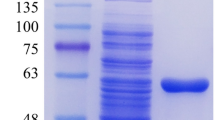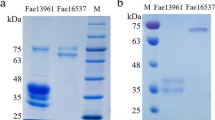Abstract
Ferulic acid esterases (FAE, EC. 3.1.1.73) hydrolyse the linkage between hemicellulose and lignin and thus have potential for use in mild enzymatic pretreatment of biomass as an alternative to thermochemical approaches. Here, we report the characterization of a novel FAE (ActOFaeI) obtained from the bacterium, Actinomyces sp. oral which was recombinantly expressed in Escherichia coli BL21 in two forms: with and without its putative signal peptide. The truncated form was found to have <10 % relative activity compared to the full length and was more prone to aggregation after purification. The enzyme with retained peptide demonstrated 2 to 4-fold higher activity against methyl caffeate and methyl p-coumarate, with specific activities of 477.6 and 174.4 U mg−1 respectively, than the equivalent activities of the benchmark FAE from Aspergillus niger A and B. ActOFaeI retained activity over a broad pH range with a maximum at 9 but >90 % relative activity at pH 6.5 and an optimum reaction temperature of 30 °C. ActOFaeI increased activity by 15 % in high salt conditions (1000 mM NaCl) and its thermal unfolding temperature improved from 41.5 °C in standard buffer to 74 °C in the presence of 2500 mM sodium malonate. ActOFaeI also released ferulic acid from destarched wheat bran when combined with a xylanase preparation. After treatment above the thermal denaturation temperature followed by cooling to room temperature, ActOFaeI demonstrated spontaneous refolding into an active state. ActOFaeI displays many useful characteristics for enzymatic pretreatment of lignocellulose and contributes to our understanding of this important family.







Similar content being viewed by others
References
Badhan A, Wang Y, Gruninger R, Patton D, Powlowski J, Tsang A, McAllister T (2014) Formulation of enzyme blends to maximize the hydrolysis of alkaline peroxide pretreated alfalfa hay and barley straw by rumen enzymes and commercial cellulases. BMC Biotechnol 14:31. doi:10.1186/1472-6750-14-31
Brown ME, Chang MC (2014) Exploring bacterial lignin degradation. Curr Opin Chem Biol 19:1–7. doi:10.1016/j.cbpa.2013.11.015
Bye JW, Falconer RJ (2013) Thermal stability of lysozyme as a function of ion concentration: a reappraisal of the relationship between the Hofmeister series and protein stability. Protein Sci 22:1563–1570. doi:10.1002/pro.2355
Chandrasekharaiah M, Thulasi A, Vijayarani K, Kumar DP, Santosh SS, Palanivel C, Jose VL, Sampath KT (2012) Expression and biochemical characterization of two novel feruloyl esterases derived from fecal samples of Rusa unicolor and Equus burchelli. Gene 500:134–139. doi:10.1016/j.gene.2012.03.027
Chiaramonti D, Prussi M, Ferrero S, Oriani L, Ottonello P, Torre P, Cherchi F (2012) Review of pretreatment processes for lignocellulosic ethanol production, and development of an innovative method. Biomass Bioeng 46:25–35. doi:10.1016/j.biombioe.2012.04.020
Chundawat SPS, Beckham GT, Himmel ME, Dale BE (2011) Deconstruction of lignocellulosic biomass to fuels and chemicals. Annu Rev Chem Biomol Eng 2:121–145. doi:10.1146/annurev-chembioeng-061010-114205
Crepin VF, Faulds CB, Connerton IF (2003) A non-modular type B feruloyl esterase from Neurospora crassa exhibits concentration-dependent substrate inhibition. Biochem J 370:417–427
Crepin VF, Faulds CB, Connerton IF (2004) Functional classification of the microbial feruloyl esterases. Appl Microbiol Biotechnol 63:647–652. doi:10.1007/s00253-003-1476-3
Edgar RC (2010) Search and clustering orders of magnitude faster than BLAST. Bioinformatics 26:2460–2461. doi:10.1093/bioinformatics/btq461
Faulds CB, Williamson G (1993) Ferulic acid esterase from Aspergillus niger: purification and partial characterization of two forms from a commercial source of pectinase. Biotechnol Appl Biochem 17(Pt 3):349–359
Faulds CB, Williamson G (1994) Purification and characterisation of a ferulic acid esterase (FAE-III) from Aspergillus niger: specificity for the phenolic moiety and binding to microcrystalline cellulose. Microbiology 140:779–787
Foglia F, Mandrich L, Pezzullo M, Graziano G, Barone G, Rossi M, Manco G, Del Vecchio P (2007) Role of the N-terminal region for the conformational stability of esterase 2 from Alicyclobacillus acidocaldarius. Biophys Chem 127:113–122. doi:10.1016/j.bpc.2007.01.004
Garcia-Conesa M-T, Crepin VF, Goldson AJ, Williamson G, Cummings NJ, Connerton IF, Faulds CB, Kroon PA (2004) The feruloyl esterase system of Talaromyces stipitatus: production of three discrete feruloyl esterases, including a novel enzyme, TsFaeC, with a broad substrate specificity. J Biotechnol 108:227–241. doi:10.1016/j.jbiotec.2003.12.003
Iiyama K, Lam TB-T, Stone BA (1994) Covalent cross-links in the cell wall. Plant Physiol 104:315–320
Ishii T (1997) Structure and functions of feruloylated polysaccharides. Plant Sci 127:111–127. doi:10.1016/S0168-9452(97)00130-1
Johnson KG, Harrison BA, Schneider H, MacKenzie CR, Fontana JD (1988) Xylan-hydrolysing enzymes from Streptomyces spp. Enzym Microb Technol 10:403–409. doi:10.1016/0141-0229(88)90034-8
Koseki T, Fushinobu S, Ardiansyah SH, Komai M (2009) Occurrence, properties, and applications of feruloyl esterases. Appl Microbiol Biotechnol 84:803–810. doi:10.1007/s00253-009-2148-8
McCarthy AJ (1987) Lignocellulose-degrading actinomycetes. FEMS Microbiol Lett 46:145–163. doi:10.1111/j.1574-6968.1987.tb02456.x
Mussatto SI, Dragone G, Roberto IC (2007) Ferulic and p-coumaric acids extraction by alkaline hydrolysis of brewer’s spent grain. Ind Crop Prod 25:231–237. doi:10.1016/j.indcrop.2006.11.001
Natale P, Brüser T, Driessen AJM (2008) Sec- and Tat-mediated protein secretion across the bacterial cytoplasmic membrane—distinct translocases and mechanisms. Biochim Biophys Acta 1778:1735–1756. doi:10.1016/j.bbamem.2007.07.015
Nieter A, Haase-Aschoff P, Linke D, Nimtz M, Berger RG (2014) A halotolerant type a feruloyl esterase from Pleurotus eryngii. Fungal Biol 118:348–357. doi:10.1016/j.funbio.2014.01.010
Palomares LA, Estrada-Mondaca S, Ramírez OT (2004) Production of recombinant proteins: challenges and solutions. In: Balbas P, Lorence A (eds) Recombinant gene expression: reviews and protocols, 2nd edn. Humana Press Inc., Totowa, pp. 15–52
Pauly M, Keegstra K (2008) Cell-wall carbohydrates and their modification as a resource for biofuels. Plant J 54:559–568. doi:10.1111/j.1365-313X.2008.03463.x
Petersen TN, Brunak S, von Heijne G, Nielsen H (2011) SignalP 4.0: discriminating signal peptides from transmembrane regions. Nat Methods 8:785–786. doi:10.1038/nmeth.1701
Pienkos PT, Zhang M (2009) Role of pretreatment and conditioning processes on toxicity of lignocellulosic biomass hydrolysates. Cellulose 16:743–762. doi:10.1007/s10570-009-9309-x
Rakotoarivonina H, Hermant B, Chabbert B, Touzel J-P, Remond C (2011) A thermostable feruloyl-esterase from the hemicellulolytic bacterium Thermobacillus xylanilyticus releases phenolic acids from non-pretreated plant cell walls. Appl Microbiol Biotechnol 90:541–552. doi:10.1007/s00253-011-3103-z
Rollin JA, Tam TK, Zhang Y-HP (2013) New biotechnology paradigm: cell-free biosystems for biomanufacturing. Green Chem 15:1708. doi:10.1039/c3gc40625c
Rose RW, Brüser T, Kissinger JC, Pohlschröder M (2002) Adaptation of protein secretion to extremely high-salt conditions by extensive use of the twin-arginine translocation pathway. Mol Microbiol 45:943–950. doi:10.1046/j.1365-2958.2002.03090.x
Seabrook SA, Newman J (2013) High-throughput thermal scanning for protein stability: making a good technique more robust. ACS Comb Sci 15:387–392. doi:10.1021/co400013v
Selig MJ, Knoshaug EP, Adney WS, Himmel ME, Decker SR (2008) Synergistic enhancement of cellobiohydrolase performance on pretreated corn stover by addition of xylanase and esterase activities. Bioresour Technol 99:4997–5005. doi:10.1016/j.biortech.2007.09.064
Shin H-D, Chen RR (2007) A type B feruloyl esterase from Aspergillus nidulans with broad pH applicability. Appl Microbiol Biotechnol 73:1323–1330. doi:10.1007/s00253-006-0612-2
Smith MM, Hartley RD (1983) Occurrence and nature of ferulic acid substitution of cell-wall polysaccharides in graminaceous plants. Carbohydr Res 118:65–80. doi:10.1016/0008-6215(83)88036-7
Till M, Goldstone DC, Attwood GT, Moon CD, Kelly WJ, Arcus VL (2013) Structure and function of an acetyl xylan esterase (Est2A) from the rumen bacterium Butyrivibrio proteoclasticus. Proteins 81:911–917. doi:10.1002/prot.24254
Tuck CO, Perez E, Horvath IT, Sheldon RA, Poliakoff M (2012) Valorization of biomass: deriving more value from waste. Science (80-) 337:695–699. doi:10.1126/science.1218930
Udatha DBRKG, Kouskoumvekaki I, Olsson L, Panagiotou G (2011) The interplay of descriptor-based computational analysis with pharmacophore modeling builds the basis for a novel classification scheme for feruloyl esterases. Biotechnol Adv 29:94–110. doi:10.1016/j.biotechadv.2010.09.003
Werpy T, Peterson G, Aden A, Bozell J, Holladay J, White J, Manheim A, Elliot D, Lasure L, Jones S, Gerber M, Ibsen K, Lumberg L, Kelley S (2004) Top value added chemicals from biomass: I—results of screening for potential candidates from sugars and synthesis gas. DOE Scientific and Technical Information. US Department of Energy, Oak Ridge, TN, http://www.nrel.gov/docs/fy04osti/35523.pdf. doi:10.2172/15008859
Yao J, Chen QL, Shen AX, Cao W, Liu YH (2013) A novel feruloyl esterase from a soil metagenomic library with tannase activity. J Mol Catal B Enzym 95:55–61. doi:10.1016/j.molcatb.2013.05.026
Acknowledgments
The authors would like to thank the Commonwealth Science and Industrial Research Organisation (CSIRO) Flagship Collaboration Fund for financial support of the project and the CSIRO Collaborative Crystallisation Centre for differential scanning fluorimetry analysis.
Author information
Authors and Affiliations
Corresponding author
Ethics declarations
Funding
This study was funded by Commonwealth Science and Industrial Research Organisation (CSIRO) Flagship Collaboration Fund in association with Monash University (fund number: 13–0182).
Conflict of interest
The authors declare that they have no competing of interests.
Ethical approval
This article does not contain any studies with human participants or animals performed by any of the authors.
Electronic supplementary material
ESM 1
(PDF 379 kb)
Rights and permissions
About this article
Cite this article
Hunt, C.J., Tanksale, A. & Haritos, V.S. Biochemical characterization of a halotolerant feruloyl esterase from Actinomyces spp.: refolding and activity following thermal deactivation. Appl Microbiol Biotechnol 100, 1777–1787 (2016). https://doi.org/10.1007/s00253-015-7044-9
Received:
Revised:
Accepted:
Published:
Issue Date:
DOI: https://doi.org/10.1007/s00253-015-7044-9




